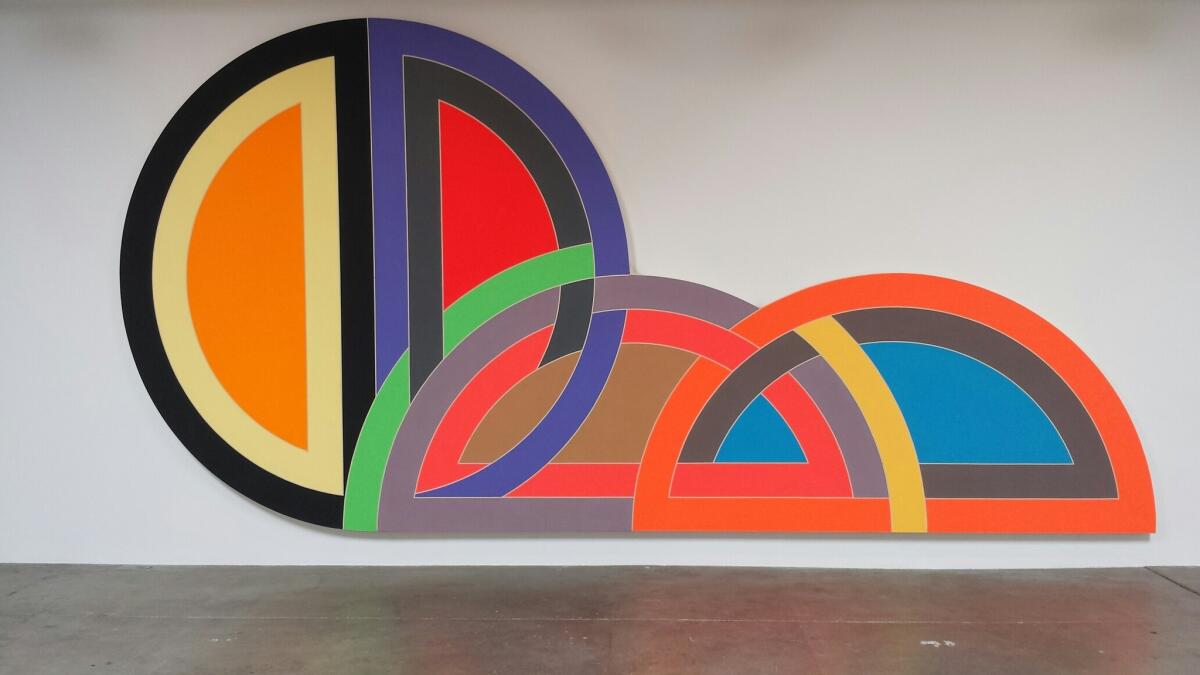Column: MOCAâs questionable painting loan to a Culver City art gallery

This is not good news: The Museum of Contemporary Art has lent a major painting from its permanent collection to a newly opened exhibition at a prominent Culver City art gallery, raising serious questions of conflict of interest.
A museum loan to a commercial enterprise is highly unusual, since the arrangement is typically irrelevant to a museumâs educational mission. Given MOCAâs recent history of troubling mercantile involvements, the gallery loan is disheartening.
The safety of the 1968 painting is also of concern. The Culver City gallery appears to fall short of best-practice standards for museum security. During a lengthy recent visit, the room in which the painting has been installed was unattended.
At issue is the loan of Frank Stellaâs monumental canvas âCtesiphon I,â which entered MOCAâs collection 14 years ago and has been shown there many times. Twenty feet wide and 10 feet high, the abstract painting is named for an ancient Mesopotamian city south of modern Baghdad.
MOCA lent the painting to Honor Fraser Gallery for âOpenness and Clarity: Color Field Works From the 1960s and 1970s,â a group show organized by New York art dealer Hayden Dunbar. It was timed to coincide with the 50th anniversary of âPost Painterly Abstraction,â a 1964 survey of new American paintings at the Los Angeles County Museum of Art. Including Stella, five of the eight artists in the Fraser show were among the 31 artists originally presented at LACMA.
The gallery is using the museum loan to market the exhibition on its website and in press materials. Ten of the Fraser showâs 13 paintings, plus the single sculpture, are for sale.
According to a MOCA spokesman, the loan was approved by the museumâs Acquisition and Collection Committee 10 days prior to the showâs June 7 opening. The same financial arrangement with museums receiving MOCA loans was required of the gallery, including insurance, transportation and payment of an administrative loan fee.
âMOCA is committed to loan artworks to encourage public enjoyment of objects,â the museum said in a statement. âMOCA lends to commercial art galleries only on a case-by-case basis.â
The written loan policy provided in a MOCA email requires a scholarly premise, a catalog and museum-quality presentation and facility requirements, plus approval of the artist (if living) and an ascertainment of the proposed exhibitionâs integrity. Because the gallery show does not meet at least the first three of those five criteria, it is unclear why approval was granted.
On rare occasions a museum might lend to a non-museum entity in order to advance new scholarship, especially through a publication; such a show is often tied to a charitable undertaking, given museumsâ nonprofit status. âOpenness and Clarity,â for which no publication or charitable event is planned, does not meet those standards.
The painting is part of Stellaâs so-called âprotractor seriesâ (1967-71), curvilinear canvases painted in flat strips of bright, sometimes fluorescent color. The shapes derive from the arcs made by the mechanical drafting tool named in the series. Other protractor examples are in the collections of Pasadenaâs Norton Simon Museum and LACMA.
In addition to Stella, the Culver City gallery show includes paintings by Helen Frankenthaler, Morris Louis, Kenneth Noland and Jules Olitski, all of whom were in the original LACMA show. There are also paintings by Josef Albers and Robert Motherwell, plus one 1976 sculpture by Anthony Caro.
MOCA has been digging out from a 2009 near-death experience, when serious financial troubles led to an unprecedented -- and ultimately unsuccessful -- experiment that saw a New York art dealer take the museumâs directing reins. Recent months have seen the arrival of a new director, the appointment of a new chief curator and pledges of more than $100 million to rebuild the battered endowment.
Cautious optimism has accompanied these developments. The current inappropriate gallery loan demonstrates that MOCA still has a ways to go.
More to Read
The biggest entertainment stories
Get our big stories about Hollywood, film, television, music, arts, culture and more right in your inbox as soon as they publish.
You may occasionally receive promotional content from the Los Angeles Times.











